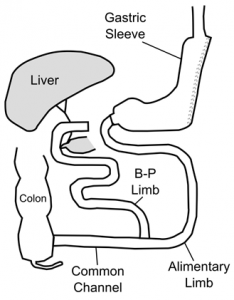 Click here to add your own text
Click here to add your own text
What is the Duodenal Switch (DS) or Biliopancreatic Diversion with Duodenal Switch (BPD-DS)?
The duodenal switch sometimes goes by the complicated name “biliopancreatic diversion with duodenal switch.” It is commonly referred to by its initials: DS, or BPD-DS. The simple way to think of this operation is that it is like a sleeve gastrectomy and gastric bypass combined. It is a very powerful operation, in that it results in excellent weight loss and control of diabetes. However, is also has more complications and side effects than any other bariatric operation. For this reason it is the least-commonly performed bariatric operation. Of note, Mount Sinai was the first program in the world to perform this operation using minimally invasive surgical techniques, back in 1999.
How is the Operation Done?
Like the other bariatric operations, the duodenal switch operation is usually done laparoscopically, using minimally invasive surgical technique.
The first part of the duodenal switch operation involves a sleeve gastrectomy. The sleeve is made a little wider than we would use for a standard sleeve gastrectomy, and roughly one half of the stomach (the left side) is permanently removed. The stomach goes from the shape of a small pineapple to the size and shape of a large banana. The pylorus, which is the valve at the outlet of the stomach, remains intact. The stomach is then connected to the last 250 centimeters (8 feet) of small intestine. The remainder of the small intestine is connected 100 centimeters from the end of the small bowel, forming the common channel, where food mixes with the digestive enzymes. The lengths of these limbs are sometimes adjusted as needed to account for individual differences.
Are there Advantages to the Duodenal Switch?
The DS is a very strong operation with regard to treating Type II diabetes. Additionally it results in excellent long-term weight loss results.
Then Why Doesn’t Everyone Get the Duodenal Switch?
The duodenal switch is a “bigger” operation because it is almost like having a sleeve gastrectomy and a gastric bypass together. Because it is a bigger operation, with more steps and more complexity, it takes more time in the operating room and has more complications than either the sleeve gastrectomy or the gastric bypass. Additionally, much more intestine is bypassed in the duodenal switch than in any other operation. This results in a large amount of malabsorption, which can give you diarrhea and vitamin deficiencies.
What Are Some of the Side Effects of Duodenal Switch?
- Frequent soft bowel movements (usually up to 4-6 per day)
- Frequent passing of foul-smelling gas
- Change in body odor
- Gas pains and bloating
- Hair loss
- Intolerance of certain foods (varies from person to person)
Because of these side effects and the increased risk of complications, most patients find that a different operation such as the sleeve gastrectomy or gastric bypass better meets their weight loss needs.
